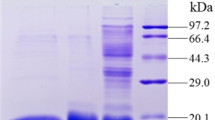Abstract
The interactions between Hg2+, Ce3+, and the mixuure of Ce3+ and Hg2+, and DNA from fish intestine in vitro were investigated by using absorption spectrum and fluorescence emission spectrum. The ultraviolet absorption spectra indicated that the addition of Hg2+, Ce3+, and the mixture of Ce3+ and Hg2+ to DNA generated an obviously hypochromic effect. Meanwhile, the peak of DNA at 205.2 nm blue-shifted and at 258.2 nm red-shifted. The size of the hypochromic effect and the peak shift of DNA by metal ion treatments was Hg2+>Hg2++Ce3+>Ce3+. The fluorescence emission spectra showed that with the addition of Hg2+, Ce3+, and the mixture of Ce3+ and Hg2+ the emission peak at about 416.2 nm of DNA did not obviously change, but the intensity reduced gradually and the sequence was Hg2+>Hg2++Ce2+>Ce3+. Hg2+, Ce3+, and the mixture of Ce3+ and Hg2+ had 1.12, 0.19, and 0.41 binding sites to DNA, respectively; the fluorescence quenching of DNA caused by the metal ions all attributed to static quenching. The binding constants (K A ) of binding siees were 8.98×104 L/mol and 1.02×104 L/mol, 5.12×104 L/mol and 1.10×103 L/mol, 6.66×104 L/mol and 2.36×103 L/mol, respectively. The results showed that Ce3+ could relieve the destruction of Hg2+ on the DNA structure.
Similar content being viewed by others
References
Y. Y. Wu, X. Wang, and R. L. Liang. Ecological effect of compound pullution of heavy metals in soil-plant system. II. Effect on element uptake by crops, alfalfa and tree, Chin. J. Appl. Ecolo. 8(5), 545–552 (1997) (in Chinese).
M. Sugiyama, Role of cellular antioxidants in metal induced damage, Cell Biol. Toxicol. 10, 1–22 (1994).
N. Xu, G. X. Shi, X. M. Zeng, et al., Damage to DNA primary structure and antixidant enzymes in Lemna minor induced by Hg2+, Acta Phytoecolog. Sini. 27(3), 299–303 (2003).
H. Ogura, T. Takeucho, and K. Morimoto, A comparison of 8-hydroxydeoxyguanosine, chromosome aberrations and micronucleus techniques for the assessment of the genotoxicity of mercury compounds in human blood lymphocytes, Mutat. Res. 340, 175–182 (1996).
L. Bucio, C. Garcia, V. Souza, et al., Uptake, cellular distribution and DNA damage produced by mercuric chloride in a human fetal hepatic cell line, Mutat. Res. 423, 65–72 (1999).
D. L. Huffman, L. M. Utschig, and T. V. O. Halloran, Mercury responsive gene regulation and mercury-199 as a probe of protein structure, Metal Ions Biol Syst. 34, 503–526 (1997).
E. Siwinska, D. Mielzynska, and L. Kapka, Association between urinary 1-hydroxypyrene and genotoxic effects in coke oven wokers, Occup. Environ. Med. 6 (13), 10 (2003) (online)
F. S. Hong, L. Wang, X. F. Wang, et al., Effects of Ce3+, Cd2+, and Hg2+ on activities and secondary structure of trypsin, Biol. Trace Element Res. 95(3), 233–240 (2003).
Z. Hossain and F. Huq, Studies on the interaction between Cd ions and DNA J. Inorg. Biochem. 90, 85–96 (2002).
T. Fatur, T. T. Lah, and M. Filipic, Cadmium inhibits repair of UV-, methyl methanesulfonate-and N-methyl-N-nitrosourea-induced DNA damage in Chinese hamster ovary cells, Mutat. Res. 529, 109–116 (2003).
Environmental Pollutant and Toxicity, Sichuan People Press, Chengdu, pp. 108–117 (1981) (in Chinese).
E. B. Hua and P. Yang, Studies on the interaction of Cu2+ and Cd2+ with poly(I:C), Polyhedron 15(12), 2067–2070 (1996).
E. B. Hua and P. Yang, Struvtural analysis for the unwinding of the triple helix Poly(A:21) induced by Cu2+, Chin. J. Struct. Chem. 15(6), 462–465 (1996) (in Chinese).
E. B. Hua and P. Yang, Studies on the interaction between Poly(I:C) and Cd2+, Chem. J. Chin. Univer. 17(8), 1185–1187 (1996) (in Chinese).
S. L. Wang, J. S. Yu, and Y. H. Zou, Spectroscopic studies on the interactions of Ag(I), Au(III), Pt(IV) with DNA, Chin. J. Inorg. Chem. 18(7), 8–12 (2002) (in Chinese).
F. L. Zeng, Y. An, and H. T. Zhang, The effects of La(III) on the peroxidation of membrane lipids in wheat seedlings leaves under osmotic stress, Biol. Trace Element Res. 69, 142 (1999).
Z. Rengel, Rare earth elements and other metals on net 45Ca2+ uptake by Amranthus protoplasts, J. Plant Physiol. 143, 47 (1994).
X. L. Zhang, G. X. Shi, Q. S. Xu, et al., Lauthanum relived toxic effects caused by nickel in Hydrocharis dubia B L. Backer leaves, J. Rare Earths 21(2), 185–190 (2003).
Mudasir, N. Yoshioka, and H. Inoue, DNA binding of iron(II) mixed-ligand complexes containing 1,10-phenanthroline and 4,7-diphenyl-1,10-phenanthroline, J. Inorg. Biochem. 77, 239–247 (1999).
J. X. Lu, G. Z. Zhang, Z.-N. Huang, et al., Study on the mechanism of the interaction between mercaptopurine metal complexes and calf thymus DNA, Acta Chim. Sin. 60(6), 967–972 (2002) (in Chinese).
M. P. Jose, I. M. Ana, M. A. Alfonso, et al., Synthesis and characterization of complexes of p-isopropyl benzaldehyde and methyl 2-pyridyl ketone thiosemicarbazones with Zn(II) and Cd(II) metallic centers. Cytotoxic activity and induction of apotosis in Pam-ras cells, J. Inorg. Biochem. 75, 255–261 (1999).
J. R. Lakowicz, Principles of Fluorescence Spectroscopy, Plenum, New York, p. 258 (1983).
E. J. Gao and Q. T. Liu, Study on the synthsis, anti-cancer activity and the interaction with DNA of compounds[Pd(L)(trp)]CL.5H 2O(L=phen,5-NO2phen), Acta Chim. Sin. 60(4, 674–680 (2002) (in Chinese).
X. L. Xu, Q. L. Liu, and Y. S. Xie, The effect of calcium(II) on the binding of anticoagulation factor II with activated coagulation factor X, Acta Chim. Sin. 59(4), 561–565 (2001) (in Chinese).
Author information
Authors and Affiliations
Rights and permissions
About this article
Cite this article
Wu, C., Hong, F., Peng, X. et al. Prevention by Ce3+ of DNA destruction caused by Hg2+ in fish intestine. Biol Trace Elem Res 106, 65–76 (2005). https://doi.org/10.1385/BTER:106:1:065
Received:
Accepted:
Issue Date:
DOI: https://doi.org/10.1385/BTER:106:1:065




